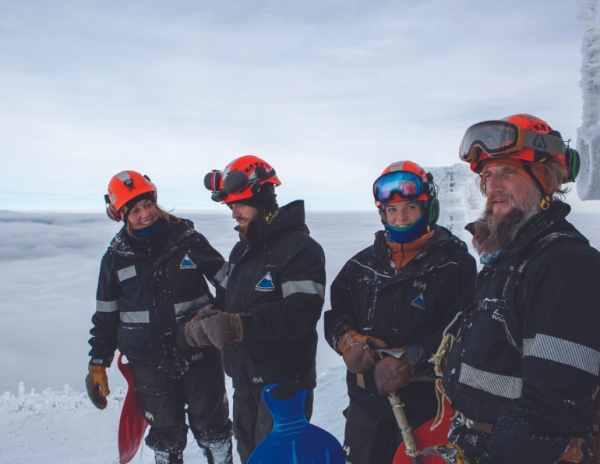Imagine this: You’re a snowmaker on a snowmaking gun run. It’s 2 a.m., and the wind is howling with snow swirling about. Visibility is 10 feet, and every step fights you. Sled guns are poking through the snow like miniature volcanoes. One hundred feet of hose—wait, what hose? The pipe has started freezing, and at shift change, all the radios were dead. Now, you’ve dropped your cell phone while trying to text for help and it’s gone. Two hours have turned into 12. Finally, as you reach the shop, exhausted, a manager approaches. They’re furious, ticked because they couldn’t reach you and expected you to check twice as many guns as you did.
You love snowmaking. There’s just nothing else like it. But after this experience, you’re reconsidering: Is this really what you want in life?
Snowmaking isn’t easy. It rests on three foundational pillars: air, water, and team. All three are essential, but the team requires the most attention.
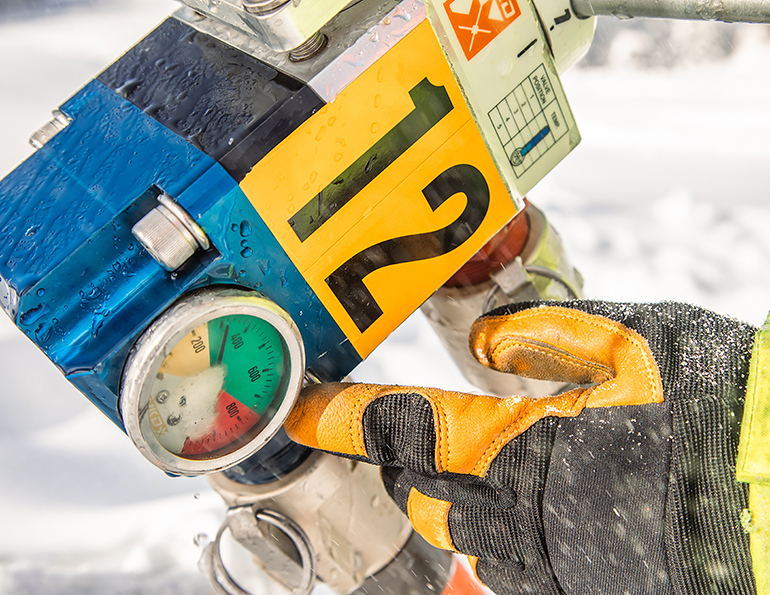 Mobile equipement requires hands-on attention. Credit: Big Sky Resort
Mobile equipement requires hands-on attention. Credit: Big Sky Resort
During the first half of my career in snowmaking I was focused on air and water, with too little attention allocated to the team. It was easier to look at efficiencies, ratios, and metrics than the bigger picture. Isn’t a sub-1.0 air/water ratio the gold standard? A resort must be leading with a 10.0 kWh/kGal ratio, right? Maybe those aren’t the most important things to focus on.
Boyne Resorts defines snowmaking effectiveness as not just doing things right, but doing the right thing. Minimizing air consumption isn’t enough. Nor is efficiently making too much snow—overproduction can negate efficiency gains. Creating an effective product requires a more comprehensive approach. To achieve this, Boyne developed a “just cause”—a specific and inspiring vision of an ideal future—to guide it’s snowmaking investments:
To create a snow surface indistinguishable from nature, produced in the most expeditious manner, with astute environmental and team member consciousness.
We believe our snow must be produced responsibly, with a focus on the team making it. And we have found that when we follow this approach, the benefits are tremendous for everyone.
BUILDING A STRONG CULTURE
The first step to achieve a team-focused snowmaking operation is establishing organizational alignment. Where are we headed? What are our goals? Without clear aims, teams are likely moving in different directions, and no one is going to be happy with the results.
Once the objectives are clearly defined, the conversation about how best to integrate the team can get started. Do you want to have 100 open acres after a certain number of run hours? Is the focus to ensure that we have a certain target for gallons pumped by Christmas? With a clear objective that you’re trying to meet, you then can start talking with the team about how to achieve it.
Let the team drive the solutions. One of my favorite ways to engage with snowmaking teams is to listen to snow plan opportunities (SPO). An SPO is something resort leadership wants to achieve—but which isn’t believed to be possible with the current snowmaking system for any multitude of reasons, from piping infrastructure to air plant capacity and staffing levels. Can we work around our limitations? If so, it will be the team members who figure this out.
 All snowmaking system components—from on-hill equipment to controls—contribute to the team member experience, for better or worse. Credit: Big Sky Resort
All snowmaking system components—from on-hill equipment to controls—contribute to the team member experience, for better or worse. Credit: Big Sky Resort
For example, say a resort wants to try opening a different top-to-bottom route than normal to improve the early season ski experience. However, to charge that route would require five separate systems and nearly 5 percent of the system capacity to maintain the overflows. As an alternative, the team believes that connecting two of the lines and changing the direction of water flow might be a possibility.
Not every SPO is fully attainable, but they present opportunities to discuss the challenges that the snowmaking team faces and collaborate on various solutions. Often, even if the SPO can’t be immediately resolved, the team can find a way to improve the situation without breaking the bank.
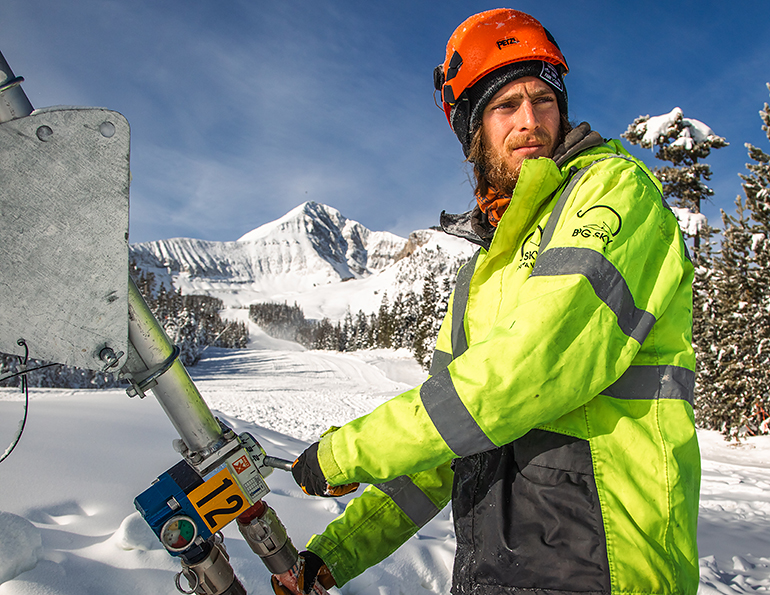 While mobile snowmaking equipment has its place, it’s more labor intensive to operate compared to fixed-position equipment.
While mobile snowmaking equipment has its place, it’s more labor intensive to operate compared to fixed-position equipment.
To paraphrase the snowmaking supervisors at Sunday River, Maine, “The team will let you know what they need to succeed, but first you need to ask questions and be willing to listen.”
Dana Higgins, snowmaking manager at Sugarloaf, Maine, agrees. “Sometimes, just listening to people’s issues and coming up with solutions to better their work experience is the most important part of my role,” he says.
“We (snowmakers) push ourselves hard, and much is asked of us to get the mountain open and keep it open. So it is imperative that leadership looks after the people who make it all possible,” he adds.
As a leader, if you aren’t engaging in these conversations to really understand how your team interacts with the system, it will be difficult to implement positive change.
Establish value. “Establishing a sense of importance around snowmaking is paramount to the success of any eastern ski resort,” says Jesse Boyd, former chief operations officer of Peak Resorts and my longtime mentor. That sentiment applies to any ski area (eastern or otherwise) that relies on snowmaking infrastructure to drive the guest experience.
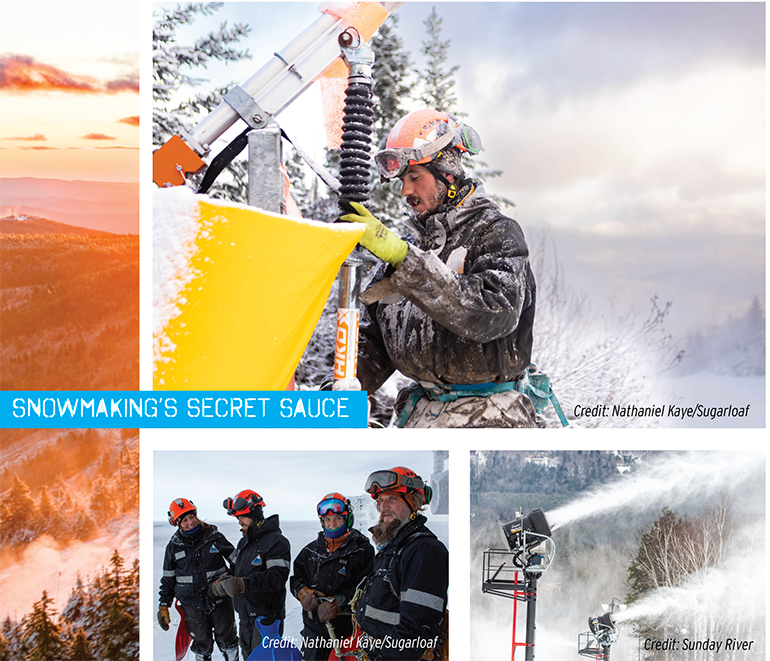 Safety and comfort in snowmaking system design, including utilizing fixed-position equipment, are key to ensuring both efficiency and team well-being.
Safety and comfort in snowmaking system design, including utilizing fixed-position equipment, are key to ensuring both efficiency and team well-being.
It is critical to align intent with action. Simply saying that snowmaking is important is not enough. “Management’s involvement in the decisions and strategy of making snow is the best way to demonstrate [the value of snowmaking] to the team,” says Boyd. “[Peak Resorts] knew that direct involvement in the process was the best way to establish a strong snowmaking culture.”
Sunday River snowmaking manager Tom Budd takes it one step further. “For a team-focused snowmaking operation, the team needs to have a voice in the decision-making process,” he says. When team members know they are making an impact on the operation, it “incentivizes them to take ownership,” he says.
The impact of that sense of ownership on snowmaking outcomes cannot be overstated. One of the great joys of making snow is the freedom to roam a mountain and play in the product you make. There is less supervision in snowmaking than nearly any industrial process that comes to mind. So, it is imperative to get buy-in from the folks on the ground making the snow. When the snowmaking team understands how they fit into the bigger picture at the resort, they will treat the resort like it’s their own—and maybe Jaws won’t sneak out at 3 a.m. when it’s 25 wet bulb anymore.
IT’S NOT AUTOMATIC
When a resort wants to improve its snowmaking system, snow gun technology is a common focus. If you search “buzzwords of 2023,” automation is right there with quiet quitting and AI. While snowmaking automation has value, it is not always the answer to improving both the snowmaking operation and the team’s experience.
To find efficiency gains and set your people up for success, you must look at what is slowing your teams down. For example, if you have fixed equipment on a vast majority of your hydrants, automation may make sense.
Conversely, if more than 20 percent of your resort’s hydrant sets feed mobile equipment, investing in a switch to fixed equipment may be the greatest opportunity you have to improve both your snow quality and team member experience. That’s because fixed equipment is easier and faster to use, meaning it’s also more efficient. The aim, remember, is to identify what is slowing down your snowmaking teams and then find solutions that allow the teams to work more quickly.
 Old mobile guns like Jaws need the right conditions to thrive—just like snowmakers.
Old mobile guns like Jaws need the right conditions to thrive—just like snowmakers.
Opportunity cost. Portable equipment presents a well-known challenge for snowmakers: It takes time and effort to relocate and set up the gear. Mobility makes sense from a financial standpoint—why use a gun once when it can be used two or three times? But the opportunity cost—the loss of potential snowmaking time needed to relocate the guns, and the manpower expended on it—is high. It’s physically and emotionally draining.
Let’s consider Trail #1, which requires 1 foot of snow to open, and on average 3 feet of snow to last throughout the season. With portable equipment, the resort must make at least 3 feet of snow on this trail initially, to save the time and expense of having to return to this trail if it needs more snow. To provide a cushion against bad weather, the most practical—although less cost- and time-efficient—thing to do is make 4 feet of snow, then strip the trail and move on.
Now consider Trail #2, which is identical to Trail #1, but has fixed equipment. The team makes 1.5 feet of snow to ensure the trail can open, and turns off the guns without moving any equipment. After a deep thaw-freeze cycle, the team again makes snow on Trail #2, and places another 6 inches of snow on the trail. The trail skis better than Trail #1, thanks to the freshly made snow, and has used a lot less energy and water than Trail #1—likely anywhere from 30 percent to 50 percent less. Plus, if the weather remains challenging, the team can get back on Trail #2 quickly to once more make snow, providing a great product for the guests.
In this example, the impact of fixed equipment on the resort and snowmaking team is significant (and that’s without considering the additional safety and productivity benefits of semi-automatic hydrants and/or full automation). Why? Because every time a snowmaker must exert energy to enable the creation of the product—that is, moving and preparing the guns—it takes away from making and perfecting it. Plus, the prep work requires a lot of energy from the snowmaking team.
Snowmakers are human! We want to be proud of our work, which is making snow. If a resort invests in a strategy that makes it easier for the team to create a high-quality product, everyone wins.
 The needs of the team should inform technology investments and operating plans. Credit: Big Sky Resort
The needs of the team should inform technology investments and operating plans. Credit: Big Sky Resort
Safety and comfort. To that end, integrating safety and comfort into snowmaking system design is a key aspect of ensuring your team knows they are valued and that your snowmaking operation is efficient.
This makes ergonomics one of the most important considerations for team-member focused snowmaking. That’s why Doug Fichera, a 20-year-plus snowmaker and the owner of Summit Resources, a full-service snowmaking solutions provider, tries to envision how to make each snowmaking task simple to perform.
For example, when building a valve station, “Would you want to climb up and down a vertical ladder several times a shift, at 3 a.m., in all weather conditions?” he asks. “Think of a valve station with easy access compared to a confined space with a hatch and ladder,” he says. Another example: the distance between the pipe and guns.
“Reducing barriers for the snowmakers to complete their duty well will improve production, reduce injuries, and create higher employee and guest satisfaction,” Fichera says.
INVEST IN YOUR TEAMS
When focus on the team is part of the investment strategy, the benefits to the snowmaking product and overall resort operations are significant.
Big Sky Resort, Mont., has invested in both its snowmaking system and snowmaking team. As the department has grown rapidly to support enhanced uphill capacity at the resort, the emphasis has been on developing the snowmaking team by involving them in summer snowmaking projects.
“This has allowed us to retain team members longer and build our experienced staff in a field that traditionally has a lot of turnover,” says Big Sky snowmaking manager Cody Cavanaugh. The byproduct of this strategy has been safer operations as well as improved efficiency and effectiveness.
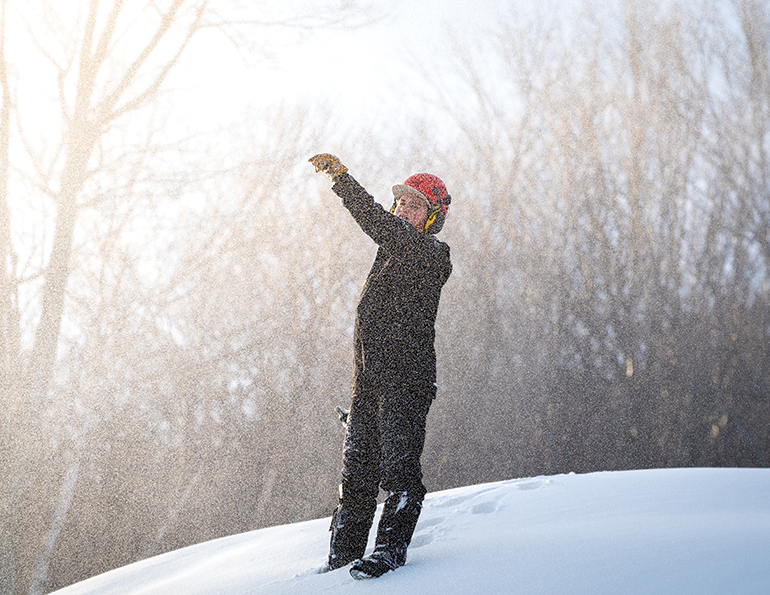 A snowmaker checks the product at Sunday River, Maine, where snowmakers are encouraged to take ownership over their work. Credit: Sunday River
A snowmaker checks the product at Sunday River, Maine, where snowmakers are encouraged to take ownership over their work. Credit: Sunday River
Of course, being involved in projects and gaining experience equates to training. In general, training is one of the most worthwhile investments an employer can make in its staff because of the high return on investment. The more your people know, the more proficient they’ll be at their jobs. Plus, when a leader takes the time to share knowledge, and cares enough to share it, team members are more apt to buy in and continue learning.
The needs of the team must also inform the technology you invest in and your plans for operating that technology. Choosing to focus on the team and how each member interacts with the systems used to execute their jobs is the most effective way to create a product that makes a resort shine from the guest’s perspective, and—most importantly—instills a sense of pride and satisfaction among the team.
Big Sky assistant snowmaking manager Tyler Bicknell sums it up well: “We want work to feel more like something you want to do and less like something you must do.”





